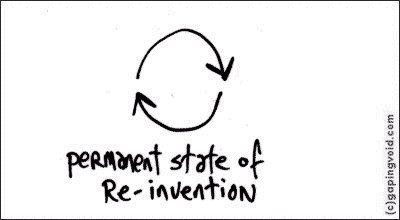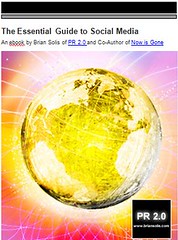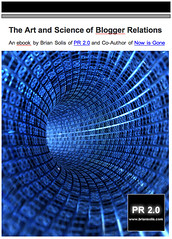SEC To Recognize Corporate Blogs as Public Disclosure, What This Means for Wires and Press Releases
Here's the director's cut, "SEC To Recognize Corporate Blogs as Public Disclosure, What This Means for Wires and Press Releases"

For several years, Sun CEO, Jonathan Schwartz has lobbied the SEC to allow disclosure of financial information through corporate blogs. In a landmark announcement, it seems that Mr. Schwartz may indeed get his wish, and with it, a historical decision that could break the age-old shackles that bound businesses to traditional media and distribution channels in order to satisfy full disclosure.
The SEC has announced that it will recognize corporate Web sites and blogs as channels for satisfying the full disclosure required by Regulation FD (Fair Disclosure).
According to the SEC announcement, "UNDER certain circumstances, companies can rely on their websites and blogs to meet the public disclosure requirements under Regulation FD (Fair Disclosure), according to new guidance unanimously approved by the US Securities and Exchange Commission today."
Chairman Christopher Cox opened up the discussion by recognizing that the Web has matured providing a big step forward for investors, "Ongoing technological advances in electronic communications have increased both the market’s and investors’ demand for more timely company disclosure and the ability for companies to capture, process and disseminate this information to market participants."
The SEC documents boundaries for sharing information as well as holding companies and their employees liable for the information that they post on blogs and discussion forums.
Disclosure is an Expensive Business
Naturally, this is at the very least, represents a potential harbinger for each of the popular wire services.
A significant percentage of their lifeblood is tied to market-relevant or earnings content that, until now, required wire services, and cost hundreds of dollars (in some cases over $1,000) per announcement in order to satisfy disclosure. For many companies, a fixed budget for disclosure absorbed the critical resources necessary to support the activity of sharing news and therefore relied upon wires to do their public and investor relations on their behalf.
But as many PR and IR professionals will concede, issuing releases on the wire is merely an expensive step in a process of creating and distributing news using traditional tools. If you represent a publicly traded company that is actively monitored by market influencers, it's very likely that your press release will reach their systems via the wire.
These days, it's almost certain that a reporter or analyst will, in the best case, see and file the release but most often, the very people we hope will find and in turn, report on the information discovered, will honestly never know that you released news at all unless they're proactively contacted. Any good public relations or investor relations professional will ensure that their top financial and business contacts are alerted to upcoming news, with or without giving away the news, in advance - depending on their interpretation of Reg FD and the trust level of their relationships.
There is no substitute for the real world relationships we forge in order to bridge the right content specifically for the right people.
Do these new guidelines offer companies the ability to shift some or all of its wire budget back into the critical role of outbound support for corporate news?
Disclosure Versus IR/PR
Disclosure relates to the market - the people who trade or may act based on the information you publish. Reg FD protects the voice and pocketbook of the investor and guides companies on how to publish information so that it reaches a fair share of the market so that no one person has access to information before the other.
We can't deny or ignore the value and benefits associated with strategic support for connecting corporate news to market influencers. Now, to the defense of wire services, and as I've written before, wire services can bypass those very influencers to reach people directly.
Not only does wire distribution meet disclosure, the art of search engine optimized press releases (SEO releases) have the unique ability to appear in search engines tied to the key words your market uses to search for related and relevant information. PR Newswire, MarketWire, Business Wire, and PRWeb offer businesses the ability to distribute news with added SEO functionality. When paired with a well-written, SEO optimized press release, wire distribution can more than satisfy disclosure, it can carry your story directly to the people looking for it.
In addition, wire services have invested over the years in the development of a secondary distribution channel that has, in my opinion, remained relevant even as the Web continues to rapidly change and evolve.
When a press release crosses a wire, many search engines and their financial properties (finance.yahoo.com or finance.google.com) and all market-powered hubs, portals and dashboards, receive wire feeds which automatically populate respective "Recent News" sections. Similar to how we subscribe to RSS feeds to seamlessly receive the news and information we prefer, investors, analysts, press, and decision makers can see, in one place, the trading status, coverage, related news, and crowd-powered discussions around the activity. This has been the case since the days of Web 1.0 and was our first taste of the finance and the Social Web as we know it today.
Without wire services, penetrating these valuable dashboards, that are still today, a primary source of financial information and activity, is incredibly difficult, if not impossible.
This new guidance, however, presents an opportunity to connect corporate information from sites and blogs to these powerful financial online hubs so that important corporate news can still reach people, the way they're used to receiving it.
Forcing them to change their habits isn't a realistic expectation in the short-term.
Regulation FD and Social Media
The SEC is taking the right steps to embrace the new tools and services that reach people in addition to wire services. With the recognition of blogs as a viable form of disclosure, under certain circumstances of course, the SEC is officially recognizing Social Media and in a sense, socializing the rules associated with Reg FD.
Perhaps, the most significant change stemming from the new SEC guidance is that Web-based disclosure does not have to appear in a format comparable to paper-based information, unless the Commission's rules explicitly require it.
This announcement finally opens the door for the Social Media Release aka a media-rich blog posts that package news with social objects in a shareable and conversational format. We're not talking about about opening the door for using a new tool to pump out the same old hype or BS.
For a few years, Todd Defren, Chris Heuer, Shannon Whitley, Shel Holtz and I, along with the rest of the Social Media Release WorkGroup, not only defended and defined the opportunity for Social Media Releases (SMRs), but also fielded emotionally-charged questions from the financial and IR communities asking about whether or not an SMR would ever meet disclosure requirements for Reg FD, and without it, what good would it ever be...
While there have been many discussions and debates to whether a Social Media Release should cross the wire and if so, what format and design it should resemble, my belief is that SMRs should always reside on dedicated blog platforms (WordPress, MoveableType) as part of a Social Media Newsroom. And, Social Media Releases should only complement a traditional press release and disclosure activity and not replace it.
Originally introduced by Todd Defren in response to Tom Foremski’s call for the death of press releases, the SMR represents a new socially-rooted format that complements traditional and SEO press releases by combining news facts and social assets in one, easy to digest, and repurpose, tool.
Giving everyone what they need and how they need it, requires a different approach. Almost every press release issued today is done so without video or audio, and many still do not include links to additional information or supporting content.
While these multimedia pieces are underlying components of SMRs, there's more to the presentation than multimedia content. The value of aggregating Social Media in one digital release connects information and content across social networks with the people looking for it, as well as the conversations that bind them together.
And not only do SMRs socialize content and link conversations across the Social Web, they also help bloggers and online journalists more effectively write a rich media post using one resource that provides them with everything they need.Now that we don't need to adhere to a fixed form or design and presentation aesthetics, technically there's holding us back from carrying the torch forward. It can only help present and share information in an alternative method that complements traditional releases, outbound contact, and market-related conference calls.
Coming back to my belief that Social Media Releases should be hosted on blogs (because they really are a combination of a blog post and a great press release) and not cross wires, with the new rules for Reg FD, an SMR by default, could now meet disclosure - assuming that the host site is recognized as meeting the disclosure standards.
Social Media Releases offer the ability to not only share relevant financial data, but also feature social content that reinforces that data and the overall company story.
We've discussed how information can reach the market, investors, peers, and customers through search as well through articles and blog posts and also via financial portals. Search engines are manipulated by SEO (search engine optimization). Social Media is powered by SMO (social media optimization) and the results are different in how, when, and where they appear. In most cases, SEO doesn't affect the outcome of content within social networks. But, dedicated tagging, key words, and crowdsourced participation drive the "discoverability" of content in the Social Web.
Picture a blog post that announced corporate data (not unlike a standard financial press release) but now, along with a custom video hosted from YouTube, supporting graphs and exec images funneled from flickr, pre-recorded audio podcasts/conferences piped in from iTunes, packaged market data sourced from Docstoc, related company and landscape stories and public commentary linked from Delicious. Content can also push to micromedia services such as Twitter, Identi.ca and FriendFeed to contribute to the company's brandstream. In a sense, the Social Media Release, hosted as an elegant and media rich blog post, acts as an aggregated hub for these disparate brand beacons, and at the same time, each piece is findable and sharable within each social network and they all point back to the Social Media Release.
Also, the SMR can feature tags and outbound links to increase exposure in social networks and blog-specific search engines.
Social Media Releases not only feature social content to more visually and authentically tell stories and share information, they also provide the tools necessary for people to further socialize and interact with them.
For readers of an SMR, the options for interaction are virtually endless. They can respond through a "moderated" comment system, much in the same way they do today in online financial forums. They can grab pieces of the content, such as embeddable video, audio, documentation and images, to repurpose as blog posts and online stories, which can also send trackbacks to help pool collective coverage. Stakeholders can subscribe to RSS feeds for the entire news stream or just those related to financial/market information. Readers can send the story back out to the social web through bookmarking tools such as diigo or delicious, as well as crowdsourced news communities including Digg and Mixx. As the existing social tools evolve and new services are introduced, the potential for SMRs aka blog posts, are truly a blank canvas for PR, marketing, and the community to define how they're read and shared.
This is a Chance to Reach More People, Their Way
Executives and marketing professionals must now weigh whether the company Web site or blog are indeed a recognized channel of distribution and more importantly, whether these online properties meet public disclosure requirements under the new rules Regulation FD.
I believe this new guidance only expands the ability to share information using a variety of approved channels - bound by the legalities of doing so ethically, honestly, and informatively. It may or may not reduce costs associated with meeting disclosure, but it will in fact, improve the infrastructure for investor and public relations by socializing the process to more effectively communicate with investors and the people who care.
No, it doesn't kill wire services or press releases, it just changes how we create and distribute them.
The reality is that businesses can only benefit by not limiting itself to one form of communication. People seek, discover, and share information differently, and combining strategic wire, Web, and blog channels will only amplify reach and visibility.
Thanks to Jennifer Leggio and the IRWebReport for getting this story started.
Follow the SEC on Twitter.
Connect with me on Twitter, Jaiku, LinkedIn, Tumblr, Pownce, Plaxo, FriendFeed, Plurk or Facebook.
Related articles on PR 2.0:
- Comcast Cares and Why Your Business Should Too, The Socialization of Service
- The Social Revolution is Our Industrial Revolution
- The Social Media Manifesto
- New Communication Theory
- The Evolution of Press Releases
- The Definitive Guide to Social Media Releases
- Wire Services Bypass Journalists and Bloggers
pr2.0 pr+2.0 pr media2.0 media 2.0 socialmedia social+media social media+2.0 brian+solis techcrunch sec reg+fd regfd regulation+fd fd regulation fair+disclosure public+relations publicrelations investor+relations investor public communications marketing IR marcom financial press+release news news+release smr smpr social+media+release hrelease



































